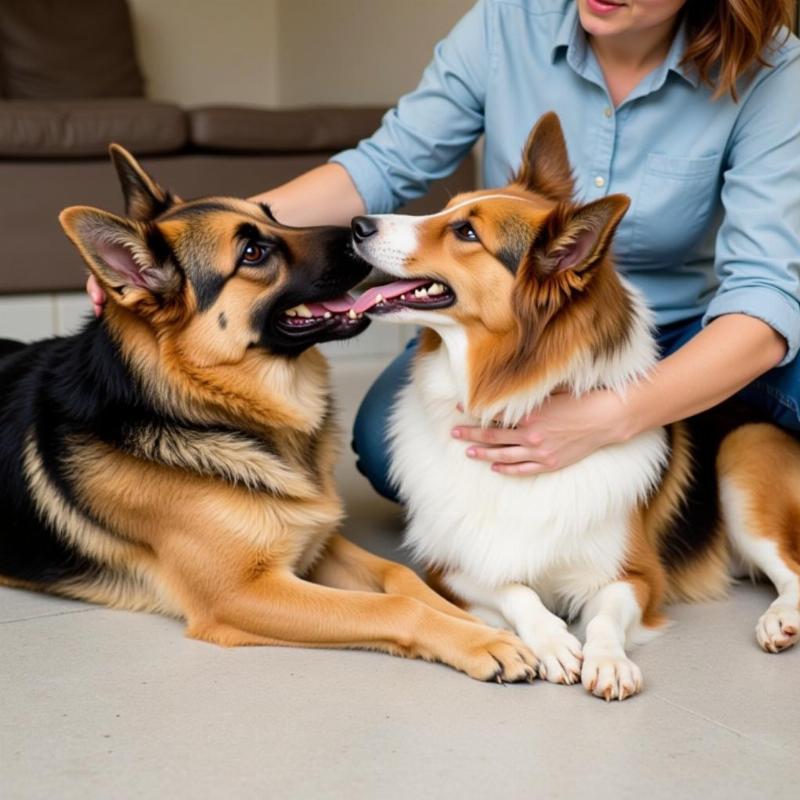Getting two female dogs can seem daunting. Will they fight? Will there be constant tension? The truth is, while there’s no guarantee of instant friendship, two female dogs can absolutely get along. Understanding canine behavior, responsible introductions, and a commitment to providing a harmonious environment can greatly increase your chances of success. This article will delve into the dynamics of female dog relationships, offering practical advice for a peaceful multi-dog household.
Understanding Female Dog Dynamics
It’s a common misconception that two female dogs are inherently incompatible. While some dogs, regardless of sex, simply don’t enjoy the company of other dogs, many female dogs thrive in pairs or even larger groups. However, female dog relationships tend to be more nuanced than those between males. Females are often more socially complex and can form strong bonds, but they can also be more prone to resource guarding and subtle displays of dominance. This doesn’t mean they are destined for conflict, but it does mean understanding their communication is key.
Factors Influencing Compatibility
Several factors can influence how well two female dogs get along:
- Age: Introducing a puppy to an older, established female can often be easier than introducing two adult females. The puppy is less likely to challenge the older dog’s authority.
- Temperament: Two laid-back, easygoing females are more likely to coexist peacefully than two high-strung, dominant individuals.
- Early Socialization: Dogs exposed to a variety of other dogs during puppyhood are generally more adaptable and socially skilled.
- Resources: Ensure adequate resources like food bowls, toys, and resting places to minimize competition.
Introducing Two Female Dogs: A Step-by-Step Guide
Introducing two female dogs properly is crucial for setting the stage for a positive relationship. Rushing the process can lead to anxiety and conflict.
- Neutral Territory: The initial introduction should take place in a neutral area where neither dog feels territorial. A friend’s yard or a nearby park is ideal.
- Leashed Introductions: Keep both dogs on leashes and allow them to sniff each other briefly. Observe their body language for signs of aggression or fear.
- Parallel Walks: If the initial sniff goes well, take the dogs for a parallel walk, keeping a safe distance between them. This allows them to get used to each other’s presence without direct interaction.
- Supervised Play: Once the dogs seem comfortable, allow them to interact off-leash in a controlled environment, always under supervision.
- Gradual Integration: Slowly integrate the new dog into your home, starting with separate spaces and gradually increasing their time together.
Maintaining Harmony in a Multi-Dog Household
Even after a successful introduction, ongoing management is essential for maintaining a peaceful household.
- Separate Feeding Areas: Feed the dogs in separate areas to prevent resource guarding.
- Individual Attention: Ensure each dog receives individual attention and affection.
- Consistent Training: Use positive reinforcement training to establish clear boundaries and expectations.
- Monitor Body Language: Pay attention to subtle shifts in body language that could indicate tension.
“Establishing a routine and providing ample resources are crucial for preventing conflict between female dogs,” says Dr. Emily Carter, a certified veterinary behaviorist. “Each dog needs her own space and access to essential resources without feeling the need to compete.”
 Owner petting two female dogs
Owner petting two female dogs
Conclusion
While introducing two female dogs can be challenging, it is certainly achievable with careful planning and ongoing management. Understanding female dog dynamics, implementing proper introductions, and providing a supportive environment can pave the way for a harmonious multi-dog household filled with love and companionship. Remember, patience and consistency are key!
FAQ
- Do female dogs always fight with each other? No, not always. While some females may clash, many can coexist peacefully, especially with proper introductions and management.
- Is it better to get two female dogs of different ages? Often, yes. An age gap can ease the introduction process as the younger dog is less likely to challenge the older dog’s authority.
- How can I prevent resource guarding between my female dogs? Provide separate feeding areas, toys, and resting places to minimize competition.
- What are some signs of tension between female dogs? Watch for stiff body posture, staring, growling, lip curling, and resource guarding.
- Should I spay my female dogs if I have two of them? Spaying can help reduce hormone-driven behaviors and the risk of unwanted pregnancies. Consult your veterinarian for personalized advice.
- What should I do if my female dogs start fighting? Separate them immediately and consult with a professional dog trainer or behaviorist.
- Can two female dogs from the same litter live together peacefully? Yes, it’s possible, but they may be more prone to littermate syndrome, requiring careful management and training.
Related Articles on Beautdogs.us
- male and female dogs together
- can you have two male dogs
- pretty dog collars for female dogs
- male rabbit and female dog compatibility
- how much do dog abortions cost
Beautdogs.us is your premier source for all things dog-related in the USA. We offer expert advice on dog breeds, care, and products, catering to both new and experienced dog owners. Our mission is to provide reliable, comprehensive, and engaging information to help you build a strong bond with your canine companion. From breed-specific guidance to training tips and product reviews, Beautdogs.us is your trusted resource for navigating the world of dog ownership. Contact us at [email protected] or +1 501-555-7529 for personalized support.